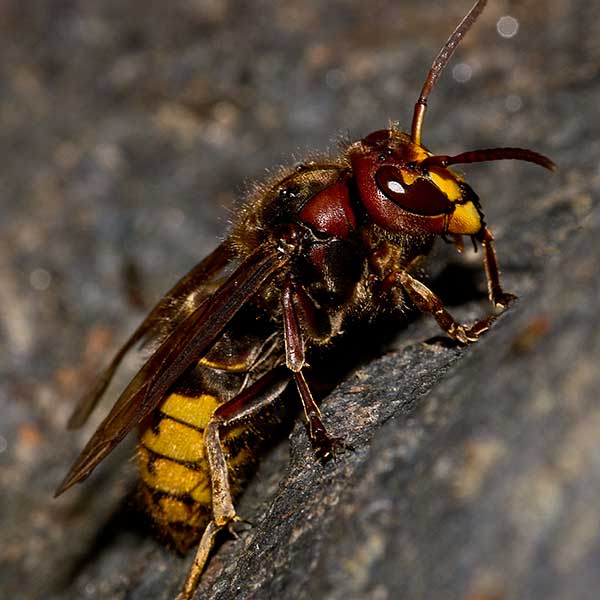Characteristics
European Hornets have a yellow, black, and burgundy/brown color pattern. They are much larger than many other wasps/hornets, with workers ranging from about 2.3-2.6 cm in length. The queens are even larger, maxing out around 3.0-3.5 cm in length. The larval stages (juveniles) of these wasps feed on pre-chewed insects provided to them by the female workers. The adults are nocturnal foragers and can be attracted to lights at night. They feed on insects and the sap of trees. The process in which they retrieve this sap is called girdling. These wasps were introduced to North America but did not originate here. The first documented record comes from New York in 1840
Identification
European hornets are larger than most wasps, measuring 1/2 to 1.4 inches long. They have yellow and black striped abdomens, reddish-brown thoraxes, and translucent wings. Their broad heads feature strong mandibles for hunting and building nests.
The Nest characteristics are paper-like and often found in hollow trees, attics, wall voids, or under eaves.
Habitat
Unlike bald-faced hornets, European hornets usually build their nests in cavities or voids. Attics, open pipes, tree holes, etc., are the perfect nesting locations for these insects. They also have a paper nest, but it’s tan in color and more brittle than the bald-faced hornet’s nest. An average hornet nest will have 200 to 400 workers by late summer, and they can become aggressive if they feel threatened.
European Hornets in America
Though native to Europe, European hornets have been present in North America since the early 1800s. They are more commonly found in the northeastern and central parts of the U.S., but their range has expanded significantly. They thrive in urban and rural settings, often establishing nests in places where humans live or work.
European Hornets Behaviors, Threats, or Dangers
These insects can be dangerous because they have nests in hidden locations that can easily be stumbled upon. While out foraging, these wasps are not generally aggressive, but if you come across their nest accidentally, they will attack to protect the nest. If you happen across one of their nests, leave the area quickly and calmly (avoid flailing as that is seen as an attack and will result in even more stings). Avoid trying to wait them out by jumping into a body of water (such as a pool or lake); they won’t go away but will wait for you to come up for air and then proceed to sting you (possibly even to death).
Need help with European Hornet Control? If a European hornet nest is suspected on your property, it is always best to contact a professional hornet control expert.
Are European Hornets Hard to Get Rid of?
European hornet control can be challenging, especially if the nest is large or in a difficult-to-reach area. The nests can grow rapidly during summer, with thousands of hornets potentially inhabiting a single colony. Hornet control is often necessary to safely and effectively remove the hornets and prevent further infestations.
How Many European Hornets Count as an Infestation?
An infestation is typically considered when a European hornet colony contains over 1,000 hornets. If you notice large numbers of hornets near your property or around a nest, it’s best to seek professional pest control help. Hornet nests can grow to be quite large, so early intervention is key to avoiding larger infestations.
Need help with pest control?
Ready for your FREE quote?
Fill out the form below and we’ll be in touch!
*During normal business hours. After hours inquiries will be returned the next business day.
FAQs:
Do European Hornets Bite or Sting?
European hornets do not bite, but they do sting. They are more likely to sting when they feel threatened, particularly if their nest is disturbed. Hornet stings can be painful and, for those allergic to their venom, may lead to serious reactions, such as swelling, difficulty breathing, or anaphylaxis.
If you experience symptoms of an allergic reaction, such as widespread swelling, dizziness, or trouble breathing, seek immediate medical advice. Even if you are not allergic, multiple stings can cause significant pain and discomfort; professional medical evaluation may be necessary.
What Is So Special About European Hornets?
European hornets are the largest hornet species in North America and are known for their aggressiveness when defending their nest. They play a role in controlling pest populations as they hunt and kill other insects. However, their large nests and painful stings make them a potential threat to humans and animals.
Are European hornets aggressive?
Yes, European hornets can be aggressive, especially if they feel their nest is threatened. They are social wasps and will defend their colony by stinging repeatedly if disturbed. However, they are less likely to sting when foraging away from the nest.
Are European hornets invasive in the US?
Yes, European hornets are considered an invasive species in the United States. They were introduced from Europe in the 1800s and have since established themselves in many parts of the country. While they help control pest populations, their presence can disrupt local ecosystems and pose risks to humans.
Should you get rid of European hornets?
Yes, if European hornets have built a nest near your home or property, it’s advisable to seek professional pest control help to remove them. Their aggressive nature and potential for painful stings make them a threat, especially to people with allergies.
Will European hornets chase you?
European hornets are not likely to chase you unless they perceive you as a threat to their nest. They may become defensive and pursue you to protect their colony if you get too close. Keeping your distance from their nest and avoiding sudden movements can help minimize the risk of being chased.





